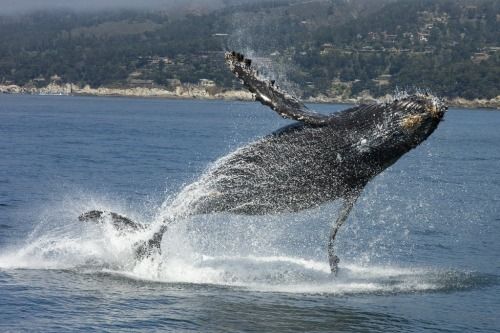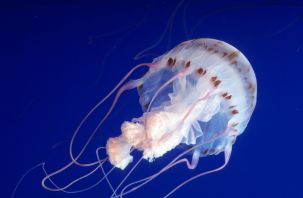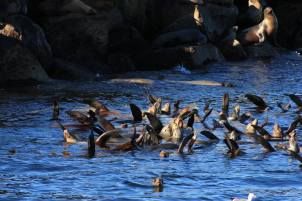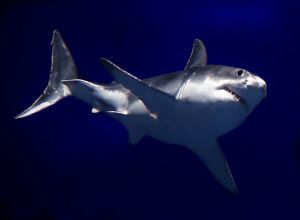California Marine Life Feeling the Heat of Climate Change

Monterey Bay is home to an astonishing array of marine life, from kelp forests to sea otters to migrating whales. The secret to its productivity: the California Current.
Monterey Bay’s rich ecosystem naturally varies in response to physical changes in the environment. But human-caused carbon dioxide emissions are driving long-term shifts that could impact fisheries and vulnerable marine species in ways we’ve never seen before.

A humpback whale breaches off the Big Sur coast. Photo ©Jim Capwell.
The California Current flows southward along the West Coast of North America delivering cool, nutrient-rich water from British Columbia to Baja California. Prevailing northwesterly winds drive the current and stimulate upwelling, a process by which cold water rises from the depths to support biodiversity off the coast.
Weird is the new normal
Life in the California Current naturally fluctuates from year to year, partially due to temperature changes, said John C. Field, a fisheries biologist with the National Oceanic and Atmospheric Administration (NOAA).

Purple-striped jellies and other gelatinous creatures sometimes dominate the California Current. The reasons are still a mystery.
In cold-water years, he says, upwelling brings nutrient-rich deep waters to the surface, typically supporting an abundance of rockfish, krill and market squid. Warm-water years, when less upwelling occurs, bring more sub-tropical species, such as pelagic red crab. Some years, jellies and other gelatinous creatures dominate the current, for reasons scientists don’t yet understand.
John participates in an ecosystem survey that monitors annual changes in marine life off the coast of California. Throughout the survey’s 33 years, he said, only one regime has dominated at a time: either a cold-water or a warm-water regime. The spring of 2015, however, was different. There were high catches of cold-water species, warm-water species, and all the gelatinous stuff.
“It was really a blend of everything,” John said. “We usually get one type of thing or the other, but nothing like this. It was a really unusual year.”
Scientists don’t know what causes weird years like this — or whether the changing climate will make them more frequent.
Fishery business
As sea surface temperatures rise, fish are getting fidgety. Scientists predict cool-water fish populations will shift farther toward the poles in the Northeast Pacific Ocean. The fish in the California Current may follow suit, said Tony Koslow, a researcher from Scripps Institution of Oceanography at the University of California, San Diego.
In a paper published last year, Tony and others found the abundance of fish in the California Current has declined dramatically for the past four decades, a trend likely driven by climate change.

Marine animals in the California Current often follow the food. Photo by Michelle Bender
The study compared two independent data sets on fish abundance in the California Current. The California Cooperative Oceanic Fisheries Investigations has collected larval fish samples since 1951, and southern California’s power plant cooling water intakes program has kept track of primarily non-commercial fish species, such as sunperch, since 1972.
The results are dramatic: Both surveys show a decline in fish abundance of more than 70 percent over the past 40 years. The biggest losses were among fish populations adapted to cool waters, such as northern anchovies, Pacific hake and rockfish.
“It shows a very strong change to the marine ecosystems off our coast,” Tony says. “Because this trend has been more or less unbroken for 40 years, it indicates climate change.”
Managing a changing sea
As we continue pumping carbon into the atmosphere by burning fossil fuels, scientists expect even more marine ecosystem scrambling. One study predicted the preferred habitats of top predators in the Pacific Ocean could shift by up to 35 percent by the year 2100.

Top ocean predators like white sharks are shifting their ranges as the sea warms.
“One of the best predictors of where top predators are concentrated in the open ocean is water temperature,” said Aquarium Research Scientist Salvador Jorgensen. “There is no question that there will be a reshuffling of species’ ranges with ocean warming.”
This could be bad news if changing conditions force vulnerable marine species out of existing protected areas. One proposed solution: employ ocean management plans that can flex based on the latest scientific data.
Connected fates
Marine animals aren’t the only creatures affected by a warming ocean. We humans are, too. For example, sea level rise increases the risk of coastal flooding, which can block roadways and damage shoreline properties. It’s just one example of how closely the ocean’s health is tied to our own.
One of the Aquarium’s partner institutions, the Center for Ocean Solutions, advocates for a nimble response. Last year, the center published a framework for bringing scientists together with Monterey Bay policymakers to create flexible management plans.
Climate change is affecting the California Current, and our coastal communities, in profound ways. But the ocean is resilient — and so are we. Working together, we can reduce carbon emissions and learn to adapt to the changes already in motion.
Learn more about our work to address the impacts of climate change on the ocean.
More Blog Posts
 Correcting the ‘Non-Debate’ Debate about Framing Climate ChangeCorrecting the ‘Non-Debate’ Debate about Framing Climate Change by Julie Sweetland, June 02 2016 Most people are familiar with the “non-debate” debate between the overwhelming majority of scientists who conclude that fossil fuels are contributing to disruptions to the climate system and the tiny but vocal few who deny it. Now, another “non-debate” [READ MORE]
Correcting the ‘Non-Debate’ Debate about Framing Climate ChangeCorrecting the ‘Non-Debate’ Debate about Framing Climate Change by Julie Sweetland, June 02 2016 Most people are familiar with the “non-debate” debate between the overwhelming majority of scientists who conclude that fossil fuels are contributing to disruptions to the climate system and the tiny but vocal few who deny it. Now, another “non-debate” [READ MORE] Global Climate Action Summit RecapGlobal Climate Action Summit Recap by Allison Arteaga, September 20 2018 One week ago, leaders from around the world gathered in San Francisco for the Global Climate Action Summit. The event celebrated ongoing efforts to curb fossil fuel emissions, while also calling for more ambitious action to meet the targets set forth by the Paris Agreement. [READ MORE]
Global Climate Action Summit RecapGlobal Climate Action Summit Recap by Allison Arteaga, September 20 2018 One week ago, leaders from around the world gathered in San Francisco for the Global Climate Action Summit. The event celebrated ongoing efforts to curb fossil fuel emissions, while also calling for more ambitious action to meet the targets set forth by the Paris Agreement. [READ MORE] Attention Environmental Advocates: Avoid ‘Cute Critters’ and other Communications TrapsAttention Environmental Advocates: Avoid ‘Cute Critters’ and other Communications Traps August 09 2016 This is the second in a series about framing ocean and climate change. A fuzzy polar bear cub against an expanse of melting snow. A seal pup slicked in oil. A newborn orangutan clutching its mother’s breast as she swings through a disappearing [READ MORE]
Attention Environmental Advocates: Avoid ‘Cute Critters’ and other Communications TrapsAttention Environmental Advocates: Avoid ‘Cute Critters’ and other Communications Traps August 09 2016 This is the second in a series about framing ocean and climate change. A fuzzy polar bear cub against an expanse of melting snow. A seal pup slicked in oil. A newborn orangutan clutching its mother’s breast as she swings through a disappearing [READ MORE] Lessons from COP23 – The Power Of CommunityLessons from COP23 – The Power Of Community Allison Arteaga, November 21 2017 Last week, the world’s leading voices on climate change gathered in Bonn, Germany for the 23rd Conference of the Parties (COP23) to the United Nations Framework Convention on Climate Change (UNFCCC). Since last year’s conference in Marrakech, the political [READ MORE]
Lessons from COP23 – The Power Of CommunityLessons from COP23 – The Power Of Community Allison Arteaga, November 21 2017 Last week, the world’s leading voices on climate change gathered in Bonn, Germany for the 23rd Conference of the Parties (COP23) to the United Nations Framework Convention on Climate Change (UNFCCC). Since last year’s conference in Marrakech, the political [READ MORE] Thinking Bigger On SolutionsThinking Bigger On Solutions by Allison Arteaga, February 28 2020 We all know that we need big, systems-level change in our society in order to address climate change and create a better future. This requires high-impact collective actions that create change at the cultural and public levels by bringing people together (Frameworks). The challenge [READ MORE]
Thinking Bigger On SolutionsThinking Bigger On Solutions by Allison Arteaga, February 28 2020 We all know that we need big, systems-level change in our society in order to address climate change and create a better future. This requires high-impact collective actions that create change at the cultural and public levels by bringing people together (Frameworks). The challenge [READ MORE]